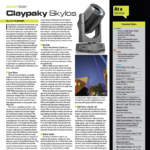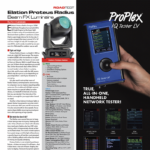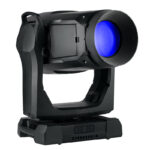Some fixtures do their best to defy categorization. In recent years, we’ve seen manufacturers release lights that attempt to fit characteristics of several types fixtures into a single unit, generally combining key aspects into a fixture released under the banner of “hybrid.” Today we look at an Ayrton fixture that combines elements of high-resolution video panels and narrow-beam LED matrices into a single fixture.
The physical form of DreamPanel™Twin follows closely in the vein of its predecessors, the MagicPanel™602 and MagicPanel™R and, at first glance, looks quite similar to Ayrton’s other square moving-head lights.
In this case, however, both sides of the head have LEDs mounted — with each side serving a separate purpose. One produces the familiar aerial beams and pixel-mapping effects of the MagicPanel, while still having utility for illuminating performances. The other is a high-resolution video display.
The capability to juxtapose the two sides in rapid succession is what makes DreamPanel Twin so distinctive — but, be warned, the two faces use two entirely different control protocols, so programming this fixture can get complicated. We’ll look at each side separately.
MagicPanel Face
One side of DreamPanel Twin has an eight-by-eight matrix, with 64 15W RGBW LED emitters. The optics are molded clear plastic TIR (Total Internal Reflection) lenses, with a small indentation in the bottom that fits over the LED dies. These lenses collimate the output and mix the colors together. The beam angle is fixed at 6º, and gives each pixel a narrow and defined beam in the air.
The collective output of the 64 emitters overlap each other to project a smooth “averaged” field at approximately 1 meter. LED dies are rotationally offset from each other on the circuit board, to help homogenize color output across the face of the fixture.
The RGBW system works as expected, projecting both saturated colors and pastels. There is some minor color-shift as the unit is dimmed, but it’s not objectionable in the context of the intended usage of this light. There are several large fans in the head to cool the LEDs and associated electronics. After allowing the head on to reach thermal equilibrium, I measured the output as 12,500 lux at five meters, which represents an output derating to 85 percent of its initial cold-start value. This performance tracks other luminaires of this type.
Measured individually, the outputs of the separate LEDs add up to more than 100 percent of the total output when all are on, indicating some load-sharing amongst the emitters. This is a good strategy to get punchier saturated colors by allowing them to run at a higher output when alone. The dimming closely follows an “S” curve, and is smooth through most of the range. There is some minor stepping noticeable in the range from 0-10 percent, but the unit otherwise fades smoothly at the very bottom end of the range all the way to blackout. There is also a strobe channel with all the expected functions, including synchronized strobes, random flashes and other effects.
Ayrton provides a number of pre-programmed macros for this side of the light, including letters, squares, lines, and other patterns. Some of these are animated, and the user can adjust the fade between frames and adjust the speed at which the animation runs.
Similar to MagicPanel units that came before, the DreamPanel Twin beam projection matrix allows the user to overlay these animations with incoming pixel mapping data to create a variety of sophisticated effects and looks. You’ll want to make sure to give yourself plenty of time in preproduction and programming to get the most out of this fixture. Control is entirely via Art-Net or sACN because, in extended mode, this light takes 272 control channels. There is the option to split control across two universes to help with data management: with LED control on one and head functions (pan, tilt, etc.) on the other. Data input is via Neutrik EtherCON in with pass-through.
As with most Ayrton display fixtures, this light features continuous, unlimited rotation on pan and tilt, a feature which is separate from the standard positional pan and tilt channels, allowing you to treat DreamPanel as a normal moving light for the majority of your programming, and then go into spin mode as needed. Positional pan and tilt range is 630º on the pan axis and 540º on tilt, and slow movements are quite smooth, without any noticeable judder. (There are menu options to set pan to a more familiar 540º, and tilt to 270º) Both axes take approximately 3.5 seconds to complete a 540º rotation.
Video Face
The reverse side of the DreamPanel Twin head is the high resolution imaging display, which consists of 4,096 RGB pixels (64 x 64). The video side is entirely driven by Ayrton’s proprietary video processor for the DreamPanel series, the DreamPanel™HD-Box.
The output of the imaging display is not primarily intended to project light as an aerial effect, so brightness is modulated for direct viewing by an audience. Of course, as with any video imaging display, there’s more to consider than just brightness. The LED dies have a viewing angle of 120º, and a pixel pitch of 6mm. From my testing, I’ll describe the display as definitely “bright enough” to be effective in a bright room, but it is much less bright than the average touring video panel of the same pixel pitch. It’s difficult to describe relative brightness in this way, and Ayrton rates the video display at 3,500 nits — certainly bright enough to use in any large arena or stadium.
One cannot describe the video display side of the fixture without discussing the video processor for the unit, the DreamPanel-HD-Box. This rack-mounted unit receives video input from any DVI-D or HDMI source and processes it for display on DreamPanel products.
The HD-Box has four HDMI outputs, each of which can handle 50 fixtures, for a total capacity of 200 DreamPanel units per HD-Box. Once the fixtures are connected, the HD-Box polls the system and allows the user to place individual fixtures “tiles” anywhere on the video raster, with an option to live update positioning as the user moves the virtual units around the canvas.
When not receiving signal, the displays output a dark red color to let the user know they are “standing by” in working order. It should be noted that the signals for video and DMX control over Ethernet are run completely separately, so this will need to be accounted for in the cabling of your rig.
Weighing 55 pounds (25kg), DreamPanel Twin is 25.2” (640mm) tall by 18.6” (473mm) wide, and the base is 12” (307mm) square. Power input is via Neutrik PowerCON TRUE1 with pass-through, and the fixture auto-ranges from 110-240VAC. Rigging is via two standard Omega brackets, and power-up and home to final output is approximately 45 seconds.
DreamPanel Twin is a fascinating addition to the Ayrton line. We’ve seen matrices of this type before from Ayrton, but using the other side as a high-resolution video display is a new idea entirely. The amount of programming planning and time required to get the most out of this sort of fixture is substantial, but rewarding in terms of the artistic vision.
At a Glance
Two-Faced (But In a Good Way)
Ayrton’s DreamPanel Twin combines a MagicPanel-style face on one side, with an 8×8 matrix of 64 15W RGBW LED modules, with a high-res (6mm) LED video screen on the other, with a 64×64 matrix of 4,096 RGB pixels. The DreamPanel Twin presents may demand time to get the most out of it, but the rewards will be well-worth the effort. This is a truly an innovative concept, and patience will reward the careful programmer with visuals to please the most jaded concertgoer.
Ayrton DreamPanel-Twin
- PROS: Unique two-sided fixture. Ability to play back high-res video, DMX controllable 8×8 matrix on MagicPanel side, continuous pan and rotation.
- CONS: None
SPECS
- Weight: 55 lbs.
- Size: 25.2” x 18.6” (H x W); 12” x 12” (base)
- LED Beam Angle (8×8 modules): 6°
- Video Pixel Pitch (Video face): 6mm
- Wattage: 990W max
- MSRP: $16,668



